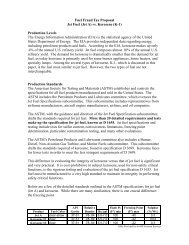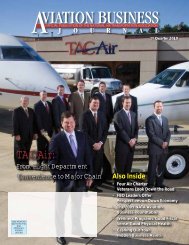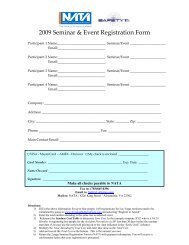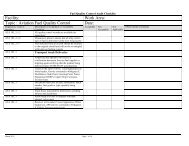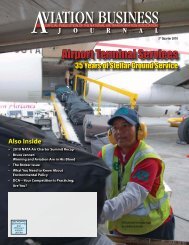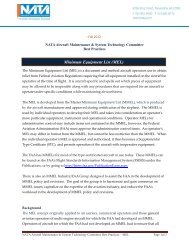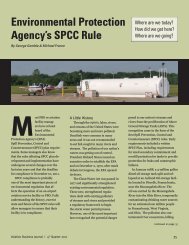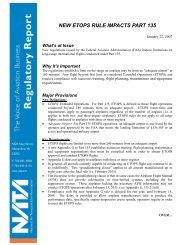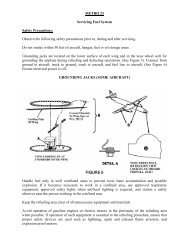You also want an ePaper? Increase the reach of your titles
YUMPU automatically turns print PDFs into web optimized ePapers that Google loves.
Health Care Reform and<br />
Small Business—Who Won?<br />
By Lindsey McFarren<br />
On March 23, the Affordable Health Care<br />
for America Act became the law of the<br />
land. Years of arguing between Democrats<br />
and Republicans and liberals and<br />
conservatives have finally come to a<br />
rather anti-climatic end. Small businesses<br />
were frequently the focus of discussions leading up<br />
to the act and with good reason.<br />
According to the federal government:<br />
• Only 45 percent of the smallest businesses currently<br />
offer health insurance to their employees,<br />
• Small business insurance premiums are on average<br />
18 percent higher than similar plans for large<br />
businesses, and<br />
• 25 percent of insurance premiums paid by small<br />
businesses goes to administrative costs; only 10<br />
percent of premiums paid by large businesses<br />
goes to administrative costs.<br />
The resulting 900+ page Affordable Health Care<br />
for America Act includes many provisions for small<br />
businesses but leaves both sides, Republicans and<br />
Democrats, wondering who actually won. I can tell<br />
you this: If you are a small business owner, regardless<br />
of your political leanings, you lost. Oh sure, the<br />
act looks pretty, advertising tax credits for small<br />
businesses, reduced premiums, and stable year-toyear<br />
pricing. But before you can take advantage of<br />
some of these perks of the act, your business must<br />
meet specific qualifications. Here’s a look at some<br />
of the small business provisions, effective dates,<br />
and implications for your company.<br />
Tax Credit — Immediately<br />
The act created a tax credit for some small businesses.<br />
The credit is effective immediately and applies<br />
to all premiums paid in 2010, even those paid<br />
prior to the passage of the act. Small businesses<br />
must meet the following qualifications to receive<br />
the credit:<br />
• The employer must currently provide health care<br />
coverage, funding at least 50 percent of the cost<br />
of coverage for some of its workers based on the<br />
individual premium rate,<br />
• The employer must have fewer than the equivalent<br />
of 25 full-time workers, and<br />
• The employer must pay average annual wages<br />
less than $50,000.<br />
Aviation Business Journal | 4 th Quarter 2010<br />
Hopefully, you didn’t see “tax credit” and “effective<br />
immediately” and decide to check out for the<br />
rest of this article. The qualification requirements<br />
must be met by your business or your tax credit<br />
disappears. The first condition is easy: If your business<br />
doesn’t offer insurance and pay at least 50<br />
percent of your employees’ premium, your company<br />
doesn’t qualify. But the next two conditions<br />
also could make you ineligible for this credit. Let’s<br />
say you own and operate an FBO and repair station.<br />
You have some full-time workers but also employ<br />
a number of part-time line service technicians,<br />
aircraft cleaners, and receptionists. If these workers’<br />
hours add up to the equivalent of 25 full-time<br />
workers, you are ineligible for this credit. Or consider<br />
an organization that has only 20 workers but<br />
their average annual wage is $50,000 or more. That<br />
organization would also be ineligible.<br />
The tax credit is almost generous: up to 35 percent<br />
of a small business’ premium costs in 2010. In<br />
2014, the credit increases to 50 percent of premium<br />
costs. But in addition to eligibility requirements,<br />
there’s a phase-out clause. The credit phases out<br />
gradually for firms with average annual wages<br />
between $25,000 and $50,000 and for firms with the<br />
equivalent of between 10 and 25 full-time workers.<br />
The companies that will benefit the most from this<br />
tax credit are those with fewer than 10 employees<br />
who make relatively low wages.<br />
I know many <strong>NATA</strong> member companies met the<br />
eligibility requirements listed in the first paragraph<br />
of this section. Sure our industry has a few monster<br />
companies, but the majority of general aviation<br />
companies are small businesses in the typical sense<br />
of the term—that is, fewer than 100 employees.<br />
Unfortunately, most <strong>NATA</strong> member companies that<br />
qualify for the credit initially will see their credit<br />
quickly phased out. Average wages are likely to exceed<br />
$25,000, and “equivalent” full-time workers are<br />
likely to exceed 10. By $50,000 annual wages and/or<br />
25 workers, the credit phases out entirely.<br />
Claiming the credit is relatively simple, assuming<br />
you meet the eligibility requirements and don’t<br />
phase out to nothing. A new tax form, Form 8941,<br />
is being developed to determine your tax credit<br />
amount. The credit will then be included as part<br />
Continued on page 16<br />
15



